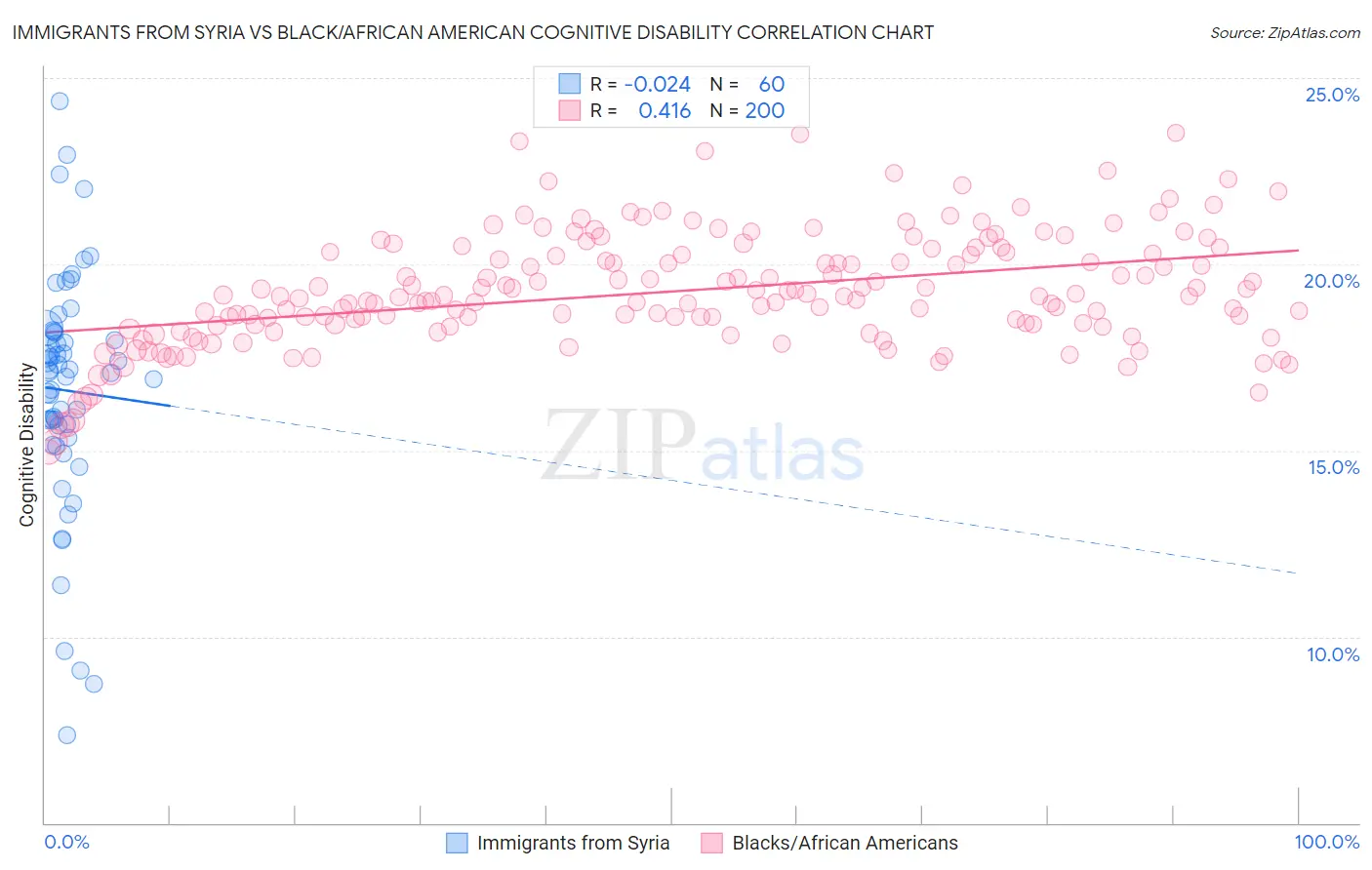Immigrants from Syria vs Black/African American Cognitive Disability
COMPARE
Immigrants from Syria
Black/African American
Cognitive Disability
Cognitive Disability Comparison
Immigrants from Syria
Blacks/African Americans
17.2%
COGNITIVE DISABILITY
63.5/ 100
METRIC RATING
167th/ 347
METRIC RANK
19.0%
COGNITIVE DISABILITY
0.0/ 100
METRIC RATING
336th/ 347
METRIC RANK
Immigrants from Syria vs Black/African American Cognitive Disability Correlation Chart
The statistical analysis conducted on geographies consisting of 174,112,347 people shows no correlation between the proportion of Immigrants from Syria and percentage of population with cognitive disability in the United States with a correlation coefficient (R) of -0.024 and weighted average of 17.2%. Similarly, the statistical analysis conducted on geographies consisting of 565,879,881 people shows a moderate positive correlation between the proportion of Blacks/African Americans and percentage of population with cognitive disability in the United States with a correlation coefficient (R) of 0.416 and weighted average of 19.0%, a difference of 10.6%.

Cognitive Disability Correlation Summary
| Measurement | Immigrants from Syria | Black/African American |
| Minimum | 7.4% | 15.0% |
| Maximum | 24.4% | 23.5% |
| Range | 17.0% | 8.6% |
| Mean | 16.6% | 19.3% |
| Median | 17.1% | 19.1% |
| Interquartile 25% (IQ1) | 15.5% | 18.3% |
| Interquartile 75% (IQ3) | 18.2% | 20.3% |
| Interquartile Range (IQR) | 2.7% | 2.0% |
| Standard Deviation (Sample) | 3.2% | 1.5% |
| Standard Deviation (Population) | 3.2% | 1.5% |
Similar Demographics by Cognitive Disability
Demographics Similar to Immigrants from Syria by Cognitive Disability
In terms of cognitive disability, the demographic groups most similar to Immigrants from Syria are Immigrants from Ecuador (17.2%, a difference of 0.030%), Immigrants (17.2%, a difference of 0.030%), Immigrants from Albania (17.2%, a difference of 0.040%), Immigrants from Portugal (17.2%, a difference of 0.050%), and Ecuadorian (17.2%, a difference of 0.12%).
| Demographics | Rating | Rank | Cognitive Disability |
| Australians | 72.4 /100 | #160 | Good 17.2% |
| Americans | 72.2 /100 | #161 | Good 17.2% |
| Yugoslavians | 71.6 /100 | #162 | Good 17.2% |
| Immigrants | Switzerland | 71.5 /100 | #163 | Good 17.2% |
| Armenians | 70.1 /100 | #164 | Good 17.2% |
| Immigrants | Albania | 64.9 /100 | #165 | Good 17.2% |
| Immigrants | Ecuador | 64.4 /100 | #166 | Good 17.2% |
| Immigrants | Syria | 63.5 /100 | #167 | Good 17.2% |
| Immigrants | Immigrants | 62.5 /100 | #168 | Good 17.2% |
| Immigrants | Portugal | 61.8 /100 | #169 | Good 17.2% |
| Ecuadorians | 59.6 /100 | #170 | Average 17.2% |
| Tlingit-Haida | 59.4 /100 | #171 | Average 17.2% |
| Immigrants | Turkey | 56.7 /100 | #172 | Average 17.2% |
| Immigrants | Northern Africa | 50.2 /100 | #173 | Average 17.3% |
| Laotians | 50.0 /100 | #174 | Average 17.3% |
Demographics Similar to Blacks/African Americans by Cognitive Disability
In terms of cognitive disability, the demographic groups most similar to Blacks/African Americans are Immigrants from Saudi Arabia (19.1%, a difference of 0.13%), Senegalese (19.0%, a difference of 0.29%), Lumbee (19.1%, a difference of 0.47%), Sudanese (18.9%, a difference of 0.84%), and Puerto Rican (19.2%, a difference of 0.95%).
| Demographics | Rating | Rank | Cognitive Disability |
| Navajo | 0.0 /100 | #329 | Tragic 18.8% |
| Immigrants | Dominican Republic | 0.0 /100 | #330 | Tragic 18.8% |
| Pima | 0.0 /100 | #331 | Tragic 18.8% |
| Immigrants | Sudan | 0.0 /100 | #332 | Tragic 18.8% |
| Immigrants | Yemen | 0.0 /100 | #333 | Tragic 18.8% |
| Sudanese | 0.0 /100 | #334 | Tragic 18.9% |
| Senegalese | 0.0 /100 | #335 | Tragic 19.0% |
| Blacks/African Americans | 0.0 /100 | #336 | Tragic 19.0% |
| Immigrants | Saudi Arabia | 0.0 /100 | #337 | Tragic 19.1% |
| Lumbee | 0.0 /100 | #338 | Tragic 19.1% |
| Puerto Ricans | 0.0 /100 | #339 | Tragic 19.2% |
| Cape Verdeans | 0.0 /100 | #340 | Tragic 19.2% |
| Tohono O'odham | 0.0 /100 | #341 | Tragic 19.3% |
| Houma | 0.0 /100 | #342 | Tragic 19.3% |
| Immigrants | Zaire | 0.0 /100 | #343 | Tragic 19.4% |